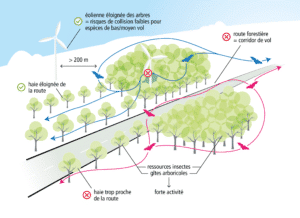A thesis on collisions with bats, successfully defended
On 14th November 2018, Charlotte Roemer defended her thesis, which was financed by Biotope and the ANRT (the National Association for Research and Technology) and supervised by the National Museum of Natural History.
A thesis to guide Biotope’s expert studies
Wind turbines and road vehicles cause numerous collisions with bats and threaten their populations. Within the framework of environmental impact studies, expert chiropterologists must assess the impacts of those projects and recommend measures to avoid them. However, the lack of scientific knowledge causes the strength of the recommendations to be limited and for that reason, Biotope decided to finance a thesis to rectify that.
Creation of an index of sensitivity to collisions
In order objectively to assess the sensitivity of each species to the risk of collisions, a sensitivity index was created, based on the number of bat corpses collected in France and the relative size of the populations of each species. For further details, please refer to our article on monitoring of chiroptera with wind masts. Today, that index is used in wind turbine impact studies to create a hierarchical structure of the impacts on the various bat species.
Effect of the landscape on risks of collision
By using a completely innovative method which consists in locating the position of bats by triangulating their echolocation calls, collision risks have been estimated for minor roads and for wind farm projects. The landscape features in the sampled sites were studied in order to identify landscapes that produced the most significant risks of collision. In this thesis, the results were set out in detail for different species, whereas in previous studies they were often grouped together for all the species without taking account of the different ecologies. Scientific articles are currently being submitted for publication and the results will soon be available.

A productive partnership
This thesis, which was begun in 2015, was financed by the ANRT (through a “CIFRE” Industrial Agreements for Training through Research grant) and by Biotope. The thesis was supervised by the National Museum of Natural History, and the Ph.D. student was hosted in the premises of the CEFE- CNRS (National Scientific Research Centre) in Montpellier. It is the 4th thesis financed by Biotope.